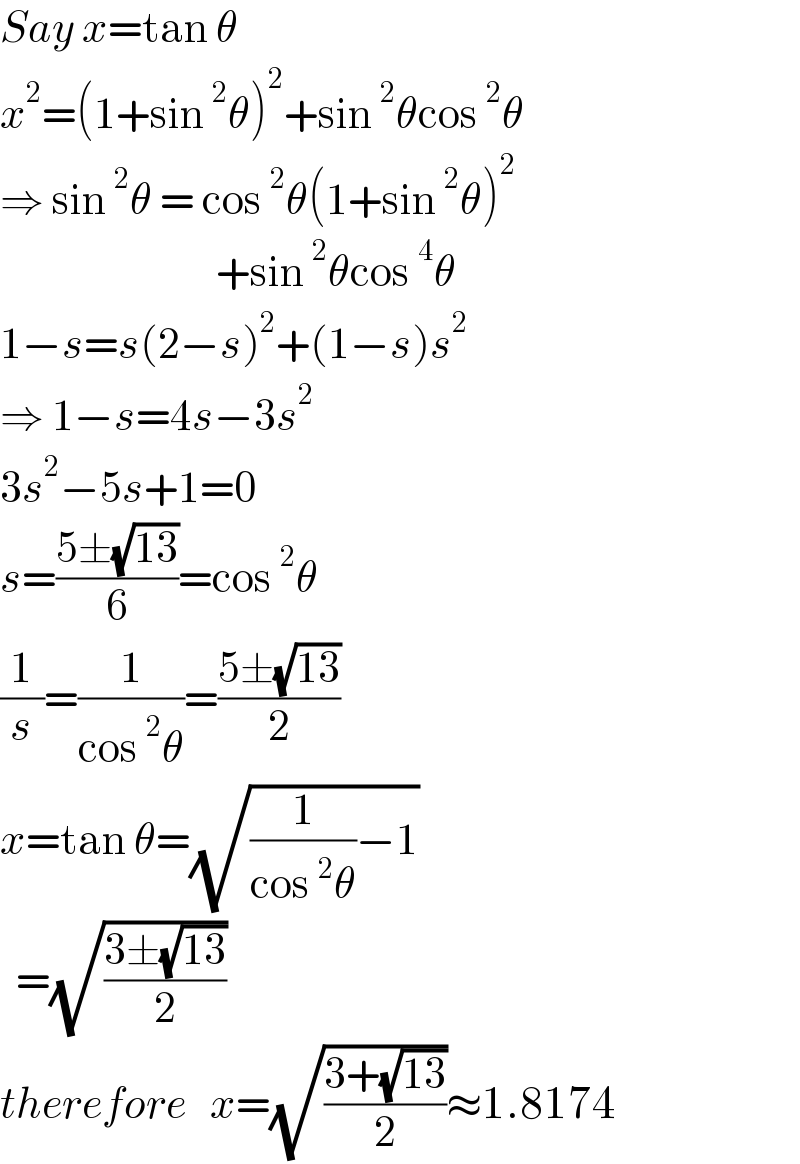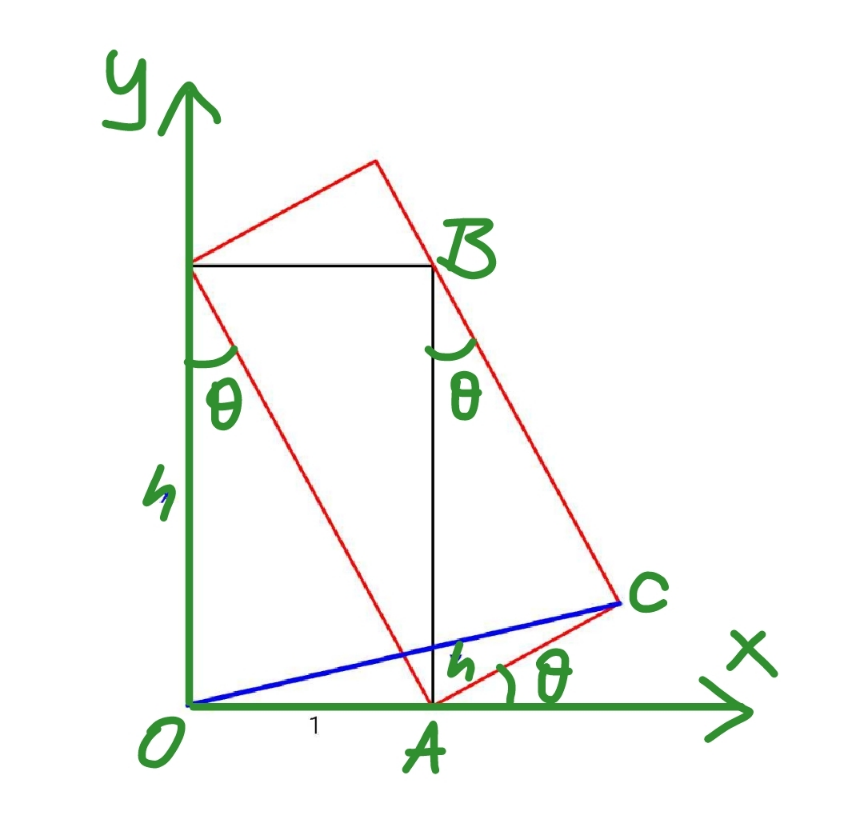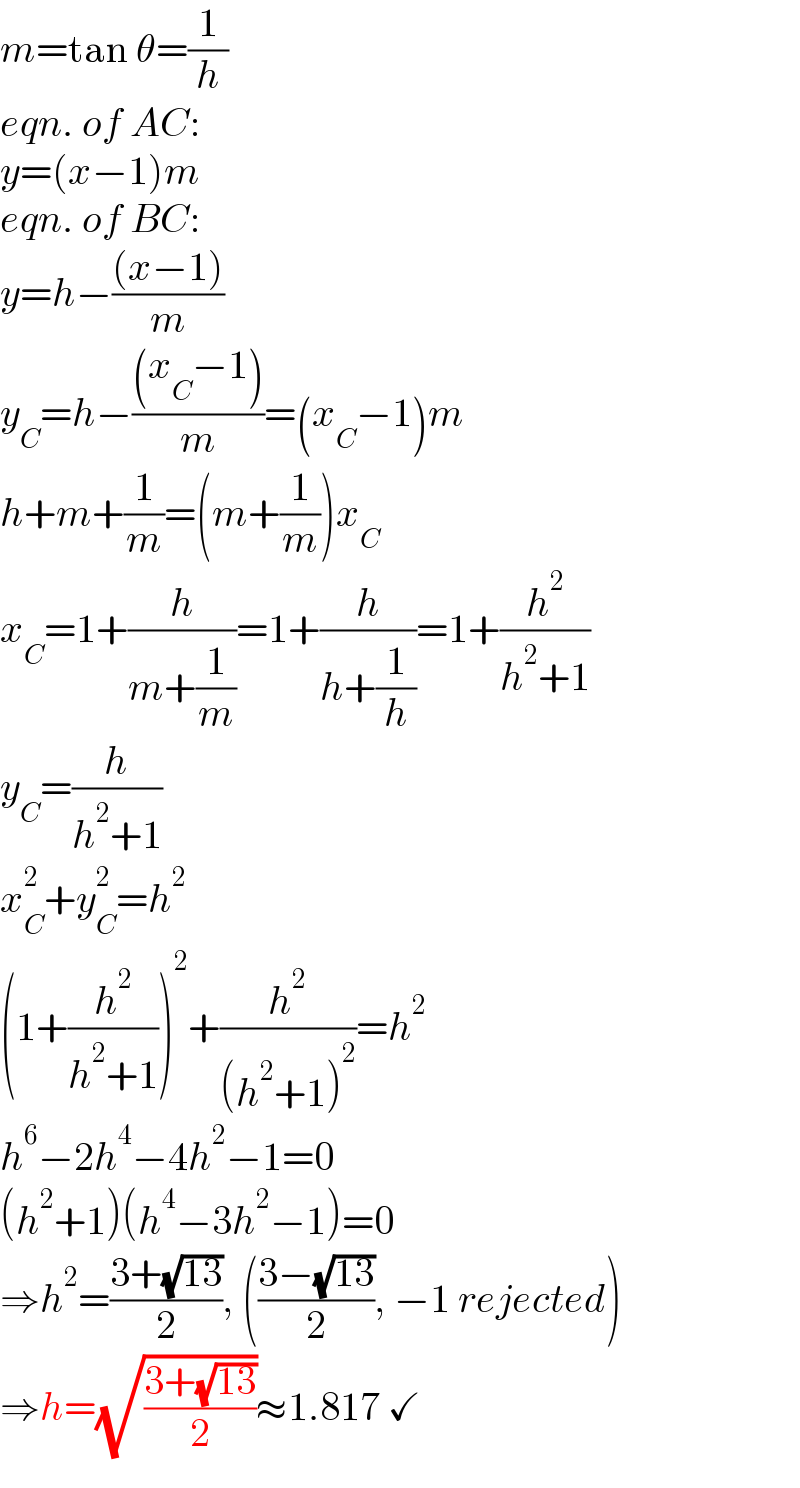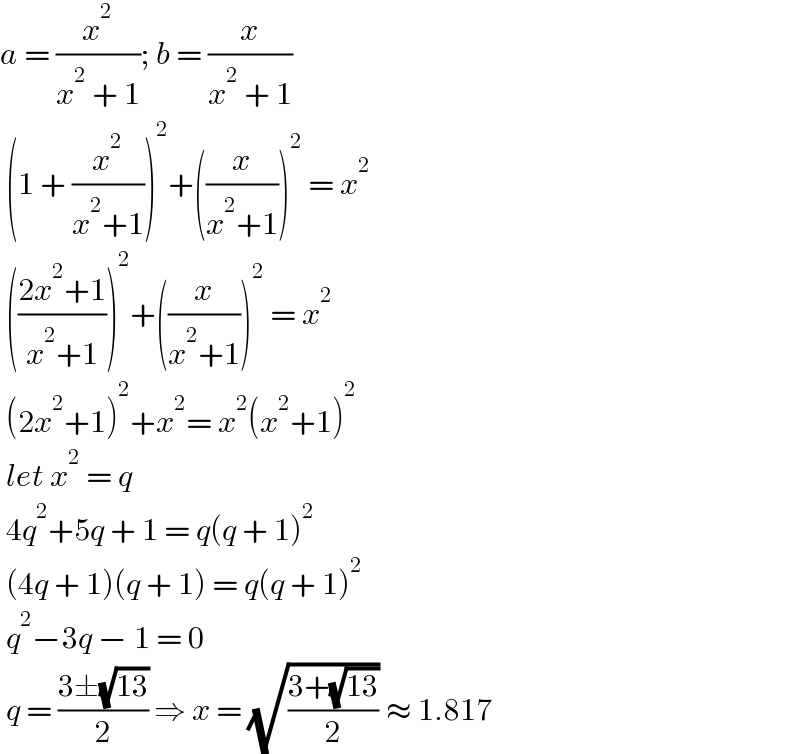
Question Number 185915 by ajfour last updated on 29/Jan/23

Commented by ajfour last updated on 29/Jan/23

$${If}\:{both}\:{blue}\:{segments}\:{have}\:{length} \\ $$$${x}\:,\:{find}\:{x}. \\ $$
Answered by ajfour last updated on 29/Jan/23

$${Say}\:{x}=\mathrm{tan}\:\theta \\ $$$${x}^{\mathrm{2}} =\left(\mathrm{1}+\mathrm{sin}\:^{\mathrm{2}} \theta\right)^{\mathrm{2}} +\mathrm{sin}\:^{\mathrm{2}} \theta\mathrm{cos}\:^{\mathrm{2}} \theta \\ $$$$\Rightarrow\:\mathrm{sin}\:^{\mathrm{2}} \theta\:=\:\mathrm{cos}\:^{\mathrm{2}} \theta\left(\mathrm{1}+\mathrm{sin}\:^{\mathrm{2}} \theta\right)^{\mathrm{2}} \\ $$$$\:\:\:\:\:\:\:\:\:\:\:\:\:\:\:\:\:\:\:\:\:\:\:\:\:\:\:+\mathrm{sin}\:^{\mathrm{2}} \theta\mathrm{cos}\:^{\mathrm{4}} \theta \\ $$$$\mathrm{1}−{s}={s}\left(\mathrm{2}−{s}\right)^{\mathrm{2}} +\left(\mathrm{1}−{s}\right){s}^{\mathrm{2}} \\ $$$$\Rightarrow\:\mathrm{1}−{s}=\mathrm{4}{s}−\mathrm{3}{s}^{\mathrm{2}} \\ $$$$\mathrm{3}{s}^{\mathrm{2}} −\mathrm{5}{s}+\mathrm{1}=\mathrm{0} \\ $$$${s}=\frac{\mathrm{5}\pm\sqrt{\mathrm{13}}}{\mathrm{6}}=\mathrm{cos}\:^{\mathrm{2}} \theta \\ $$$$\frac{\mathrm{1}}{{s}}=\frac{\mathrm{1}}{\mathrm{cos}\:^{\mathrm{2}} \theta}=\frac{\mathrm{5}\pm\sqrt{\mathrm{13}}}{\mathrm{2}} \\ $$$${x}=\mathrm{tan}\:\theta=\sqrt{\frac{\mathrm{1}}{\mathrm{cos}\:^{\mathrm{2}} \theta}−\mathrm{1}} \\ $$$$\:\:=\sqrt{\frac{\mathrm{3}\pm\sqrt{\mathrm{13}}}{\mathrm{2}}} \\ $$$${therefore}\:\:\:{x}=\sqrt{\frac{\mathrm{3}+\sqrt{\mathrm{13}}}{\mathrm{2}}}\approx\mathrm{1}.\mathrm{8174} \\ $$
Commented by ajfour last updated on 29/Jan/23

Answered by mr W last updated on 29/Jan/23

Commented by mr W last updated on 29/Jan/23

$${m}=\mathrm{tan}\:\theta=\frac{\mathrm{1}}{{h}} \\ $$$${eqn}.\:{of}\:{AC}: \\ $$$${y}=\left({x}−\mathrm{1}\right){m} \\ $$$${eqn}.\:{of}\:{BC}: \\ $$$${y}={h}−\frac{\left({x}−\mathrm{1}\right)}{{m}} \\ $$$${y}_{{C}} ={h}−\frac{\left({x}_{{C}} −\mathrm{1}\right)}{{m}}=\left({x}_{{C}} −\mathrm{1}\right){m} \\ $$$${h}+{m}+\frac{\mathrm{1}}{{m}}=\left({m}+\frac{\mathrm{1}}{{m}}\right){x}_{{C}} \\ $$$${x}_{{C}} =\mathrm{1}+\frac{{h}}{{m}+\frac{\mathrm{1}}{{m}}}=\mathrm{1}+\frac{{h}}{{h}+\frac{\mathrm{1}}{{h}}}=\mathrm{1}+\frac{{h}^{\mathrm{2}} }{{h}^{\mathrm{2}} +\mathrm{1}} \\ $$$${y}_{{C}} =\frac{{h}}{{h}^{\mathrm{2}} +\mathrm{1}} \\ $$$${x}_{{C}} ^{\mathrm{2}} +{y}_{{C}} ^{\mathrm{2}} ={h}^{\mathrm{2}} \\ $$$$\left(\mathrm{1}+\frac{{h}^{\mathrm{2}} }{{h}^{\mathrm{2}} +\mathrm{1}}\right)^{\mathrm{2}} +\frac{{h}^{\mathrm{2}} }{\left({h}^{\mathrm{2}} +\mathrm{1}\right)^{\mathrm{2}} }={h}^{\mathrm{2}} \\ $$$${h}^{\mathrm{6}} −\mathrm{2}{h}^{\mathrm{4}} −\mathrm{4}{h}^{\mathrm{2}} −\mathrm{1}=\mathrm{0} \\ $$$$\left({h}^{\mathrm{2}} +\mathrm{1}\right)\left({h}^{\mathrm{4}} −\mathrm{3}{h}^{\mathrm{2}} −\mathrm{1}\right)=\mathrm{0} \\ $$$$\Rightarrow{h}^{\mathrm{2}} =\frac{\mathrm{3}+\sqrt{\mathrm{13}}}{\mathrm{2}},\:\left(\frac{\mathrm{3}−\sqrt{\mathrm{13}}}{\mathrm{2}},\:−\mathrm{1}\:{rejected}\right) \\ $$$$\Rightarrow{h}=\sqrt{\frac{\mathrm{3}+\sqrt{\mathrm{13}}}{\mathrm{2}}}\approx\mathrm{1}.\mathrm{817}\:\checkmark \\ $$
Commented by ajfour last updated on 29/Jan/23

$${Thank}\:{you}\:{sir}. \\ $$
Answered by HeferH last updated on 29/Jan/23

Commented by HeferH last updated on 29/Jan/23

$${a}\:=\:\frac{{x}^{\mathrm{2}} }{{x}^{\mathrm{2}} \:+\:\mathrm{1}};\:{b}\:=\:\frac{{x}}{{x}^{\mathrm{2}} \:+\:\mathrm{1}} \\ $$$$\:\left(\mathrm{1}\:+\:\frac{{x}^{\mathrm{2}} }{{x}^{\mathrm{2}} +\mathrm{1}}\right)^{\mathrm{2}} +\left(\frac{{x}}{{x}^{\mathrm{2}} +\mathrm{1}}\right)^{\mathrm{2}} \:=\:{x}^{\mathrm{2}} \\ $$$$\:\left(\frac{\mathrm{2}{x}^{\mathrm{2}} +\mathrm{1}}{{x}^{\mathrm{2}} +\mathrm{1}}\right)^{\mathrm{2}} +\left(\frac{{x}}{{x}^{\mathrm{2}} +\mathrm{1}}\right)^{\mathrm{2}} \:=\:{x}^{\mathrm{2}} \\ $$$$\:\left(\mathrm{2}{x}^{\mathrm{2}} +\mathrm{1}\right)^{\mathrm{2}} +{x}^{\mathrm{2}} =\:{x}^{\mathrm{2}} \left({x}^{\mathrm{2}} +\mathrm{1}\right)^{\mathrm{2}} \\ $$$$\:{let}\:{x}^{\mathrm{2}} \:=\:{q} \\ $$$$\:\mathrm{4}{q}^{\mathrm{2}} +\mathrm{5}{q}\:+\:\mathrm{1}\:=\:{q}\left({q}\:+\:\mathrm{1}\right)^{\mathrm{2}} \\ $$$$\:\left(\mathrm{4}{q}\:+\:\mathrm{1}\right)\left({q}\:+\:\mathrm{1}\right)\:=\:{q}\left({q}\:+\:\mathrm{1}\right)^{\mathrm{2}} \\ $$$$\:{q}^{\mathrm{2}} −\mathrm{3}{q}\:−\:\mathrm{1}\:=\:\mathrm{0} \\ $$$$\:{q}\:=\:\frac{\mathrm{3}\pm\sqrt{\mathrm{13}}}{\mathrm{2}}\:\Rightarrow\:{x}\:=\:\sqrt{\frac{\mathrm{3}+\sqrt{\mathrm{13}}}{\mathrm{2}}}\:\approx\:\mathrm{1}.\mathrm{817} \\ $$
Commented by ajfour last updated on 29/Jan/23

$${thanks}\:{sir}. \\ $$
